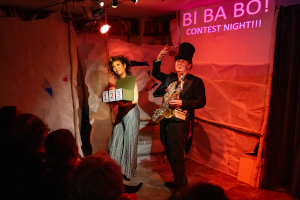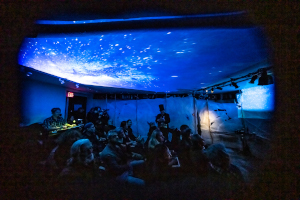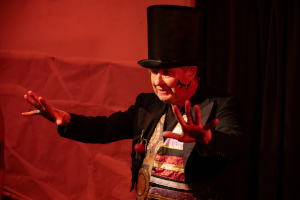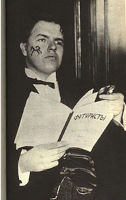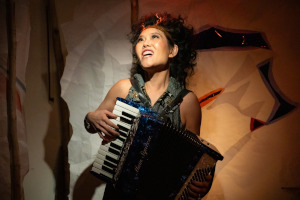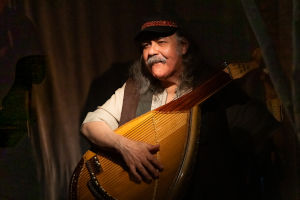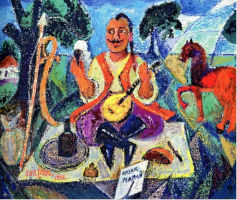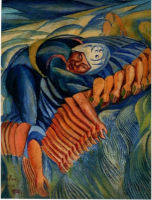
|
Beate Hein Bennett
Slapped
backwards into Future January 23 – February 9, 2025
Step down a steep staircase into a tiny basement performing space, the original LaMama space where Ellen Stewart rang her famous little bell, to relish the amazing trajectory of David Burliuk (1882-1967), a major 20th century Ukrainian artist. David Burliuk’s life and art journey took him from the Ukrainian Steppes to France, Germany, Russia, via Siberia to Japan, and finally to 10th Street in the East Village—all that between 1902 and 1924. The Yara Arts ensemble regales the audience to the rich world of Burliuk’s visual and verbal art that incorporated all the major revolutionary artistic movements from Cubism and Fauvism—the Fauves were the “wild ones”—to Futurism (without Marinetti’s fascist stance), passing playfully through Dadaism, Expressionism, Abstract Expressionism and more. Burliuk drank from all the inspiring artistic sources and personalities that he encountered on his journey, and wherever he found kindred spirits, he initiated avant-garde events in the most unlikely places during most unlikely times.
About “Slap!”: In 1912, Burliuk published a manifesto with the title, “A Slap in the Face of Public Taste” in which he invokes the Dadaist formula of nonsensical sensory language that slaps the audience ears with sounds and bangs in a cabaret-style performance, free from any rational restriction and physical constrictions—a slap in the face of bourgeois audience expectations of Art as moral edification. The most famous cabarets before, during, and after WWI were in Munich, most likely attended by Burliuk, and Zürich (attended by Lenin!), and Berlin. The performances mostly took place in small private bars, restaurants, or in basements. The combinations of painting, poetry, theater, dance, and art installation followed a similar aesthetic for a purely sensory impact-- often to humorous effect-- and were geared to upend any established academic, social, or political norms.
The Yara Arts Group ensemble takes Burliuk (and us) into a deeper level of his Ukrainian origin and identity. A mythical Scythian Viper Goddess—the Ur-mother of the Scythians that inhabited the steppes of present-day Ukraine-- awakens him with a loud gong, the proverbial “slap” that sends him into action to become an artist with a mission: To unearth the Scythian “gold” that lies deep within Ukrainian culture, its land, and its people. Besides the Viper Goddess there is Mamai, an archetypal Horseman who roamed the Steppe. Both figures become motifs in Burliuk’s early paintings. Susan Hwang, the Scythian Viper Goddess, adorned in a shimmery costume, a gold ornament snaking through her wild curly raven-black coif, enters the stage. She carries herself with an unearthly authority leavened by a comedic sense of humor; her lyrics of the Viper Woman Song are a hilarious mix of downtown lingo and mythic exhortation delivered with a twinkle in her expressive large eyes. Julian Kytasty, a renowned bandura player, introduces us to Mamai with two traditional songs, sung expressively in Ukrainian, “Mamai” and “Pushchu konia.” Bob Holman embodies David Burliuk with infectious energy. Holman is a poet who understands the foundational aspect of poetry as speech in motion. He is a big man but nimbly negotiates the tiny stage space and the close proximity to the audience. All three actor/singers inhabit Burliuk’s rangy universe with panache, humor, and emotional depth. Virlana Tkacz, the Artistic Director/Founder of Yara Arts Group (founded in 1990), is the guide of the event with artistic input from all creative partners, notably Watoku Ueno, the set and lighting designer who transformed the tiny space imaginatively with simple materials, such as birch branches--Ukrainian/Russian/Chekhovian and white paper walls, magically lit from behind-- Japanese aesthetic, that added hidden entrances for the actors. (I also noticed books lined the walls below the ceiling, apparently a permanent fixture of the space.) Above the acting space, projections of Burliuk’s art showed the artist’s development of diverse styles. Darien Fiorino designed the projections and props with graphics by Waldemart Klyusko. The lovely Viper Goddess costume and Burliuk’s motley cabaret costume were designed by Keiko Obremski.
“Slap!” takes the audience on a concentrated journey through the world of art, through global history, and even the global world of NYC’s East Village, traditionally a place of immigration from Eastern Europe, more particularly Ukraine (note nearby Veselka, a supporter of the production, and the Ukrainian National Home Restaurant); the Variety Theatre, the home of Yiddish Broadway until the 70s (now the Village Cinema); and for the past sixty years, avant-garde performance art happening in the nooks and grannies of the old tenement houses. So, if you want to breathe the air of (almost) yesteryear, come down to 9th Street between First and Second avenues, climb down those hidden steep stairs into the basement--and enjoy a special treat! |
| recordings | coupons | publications | classified |
